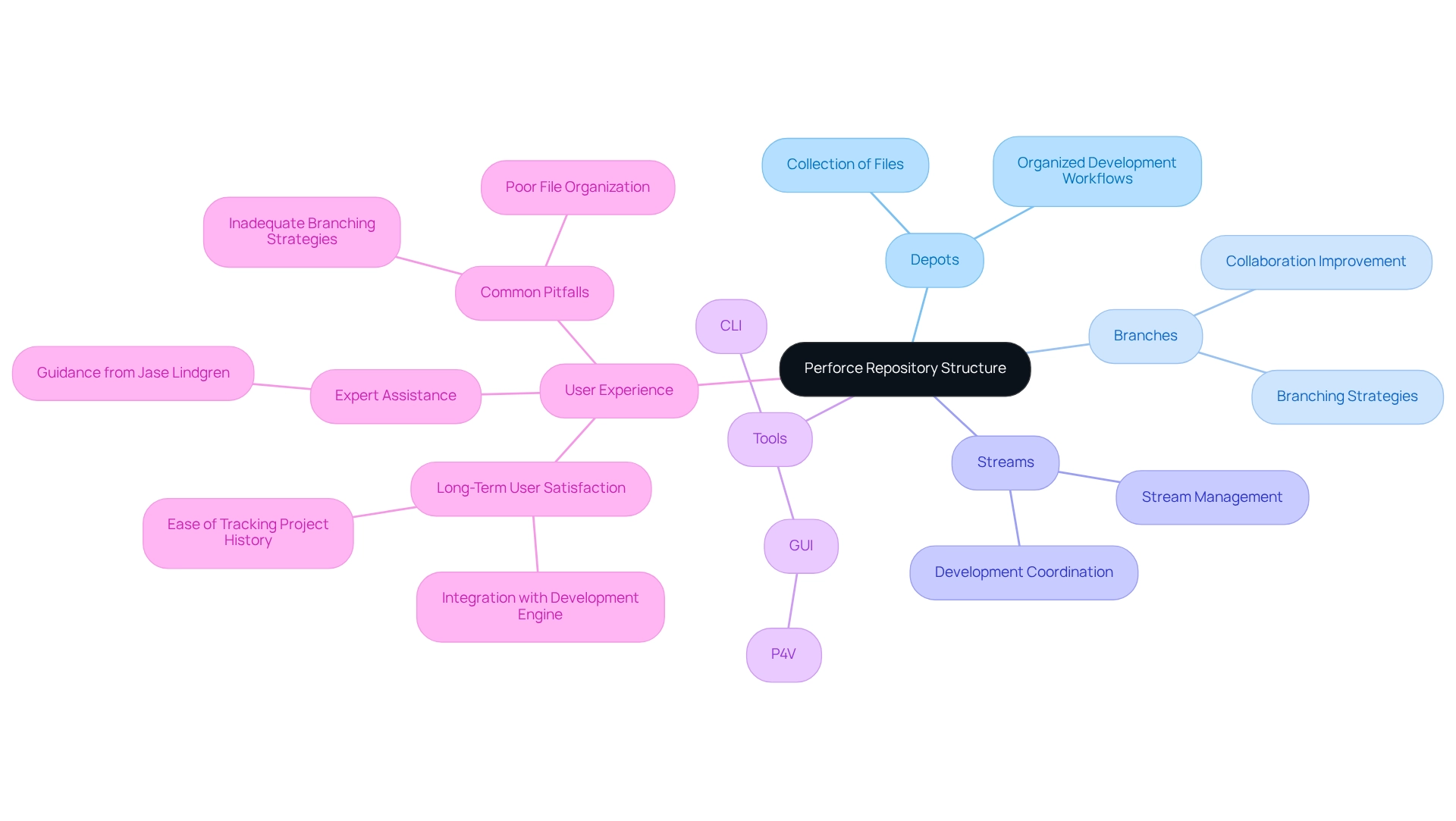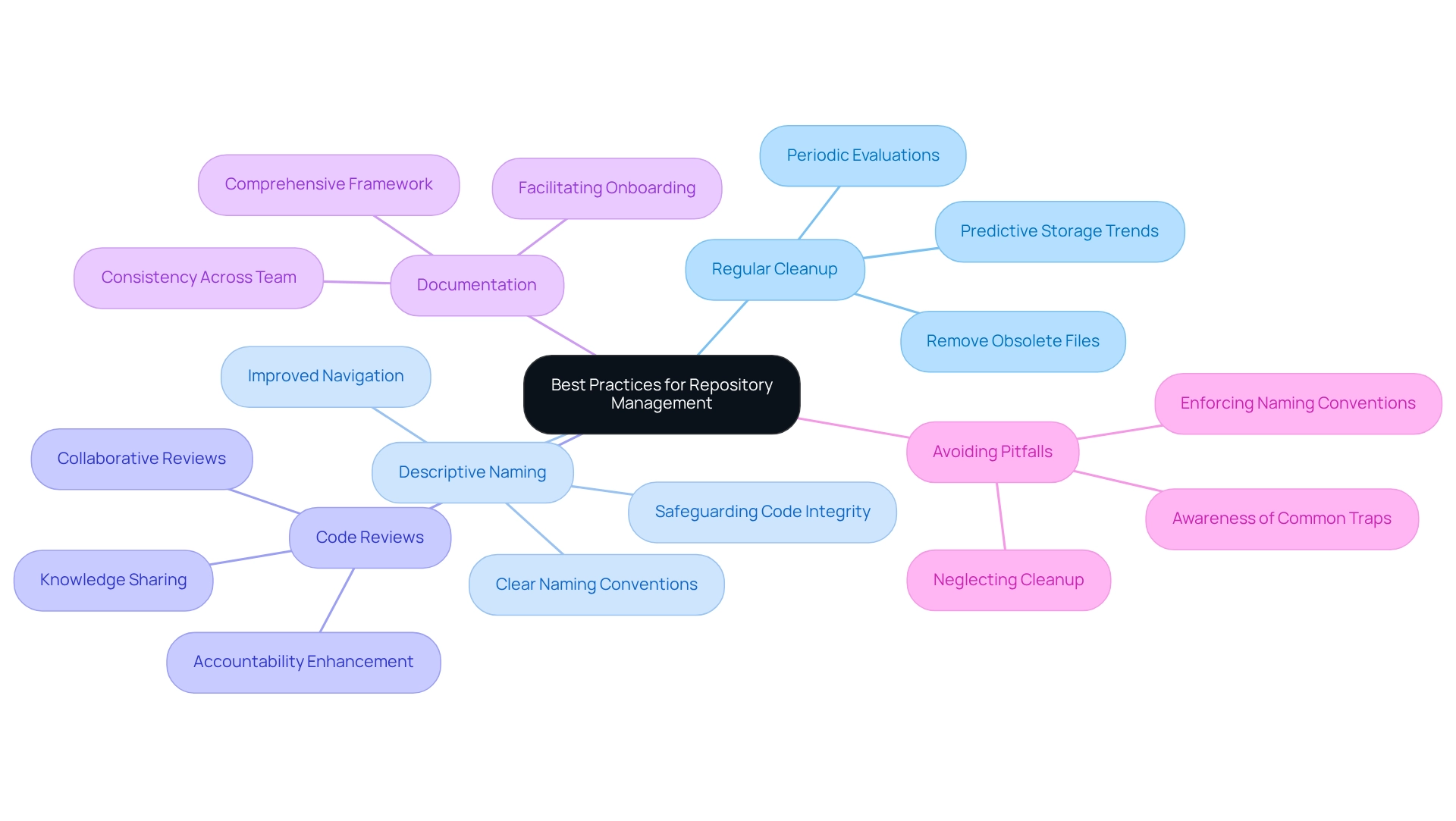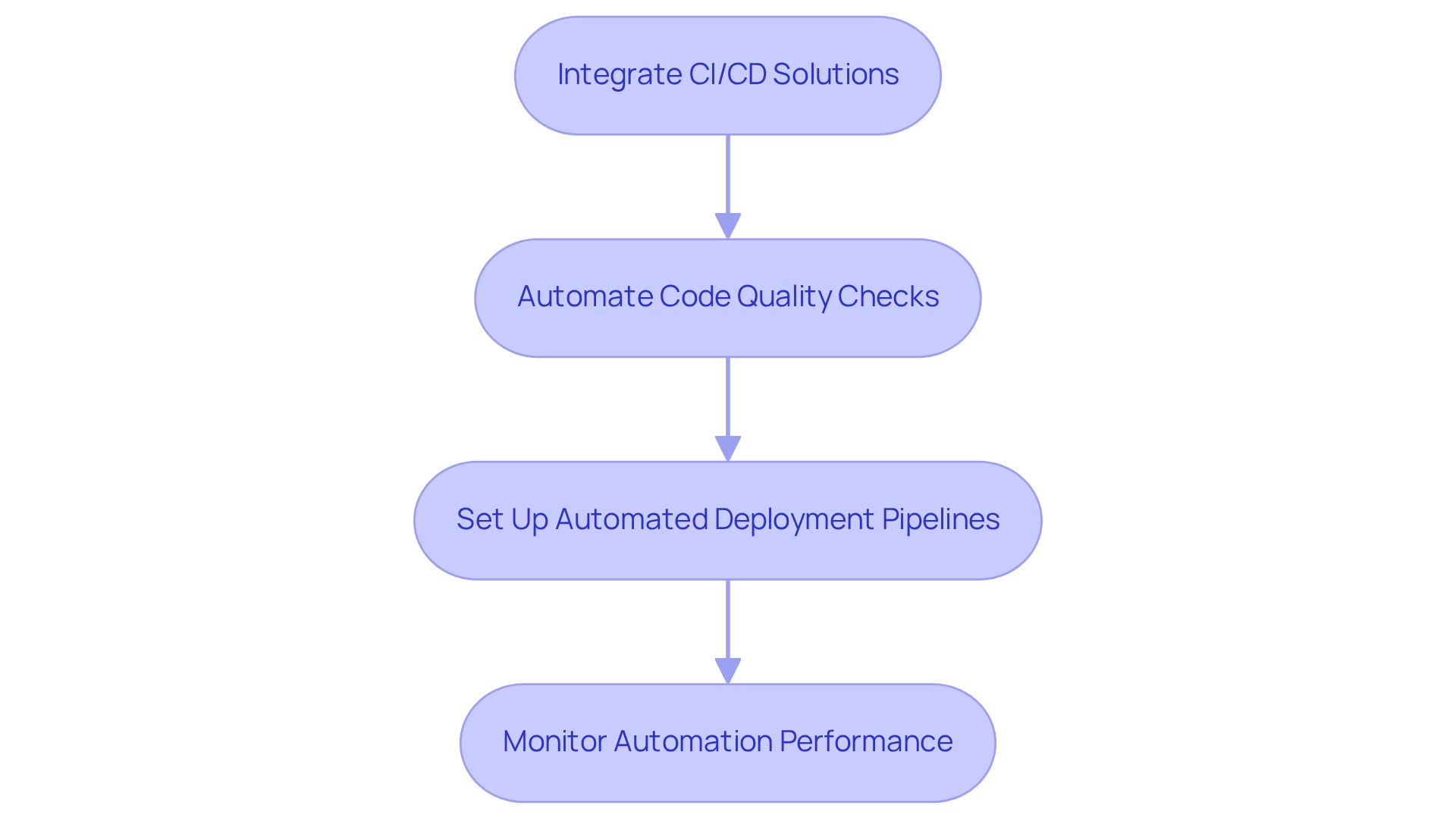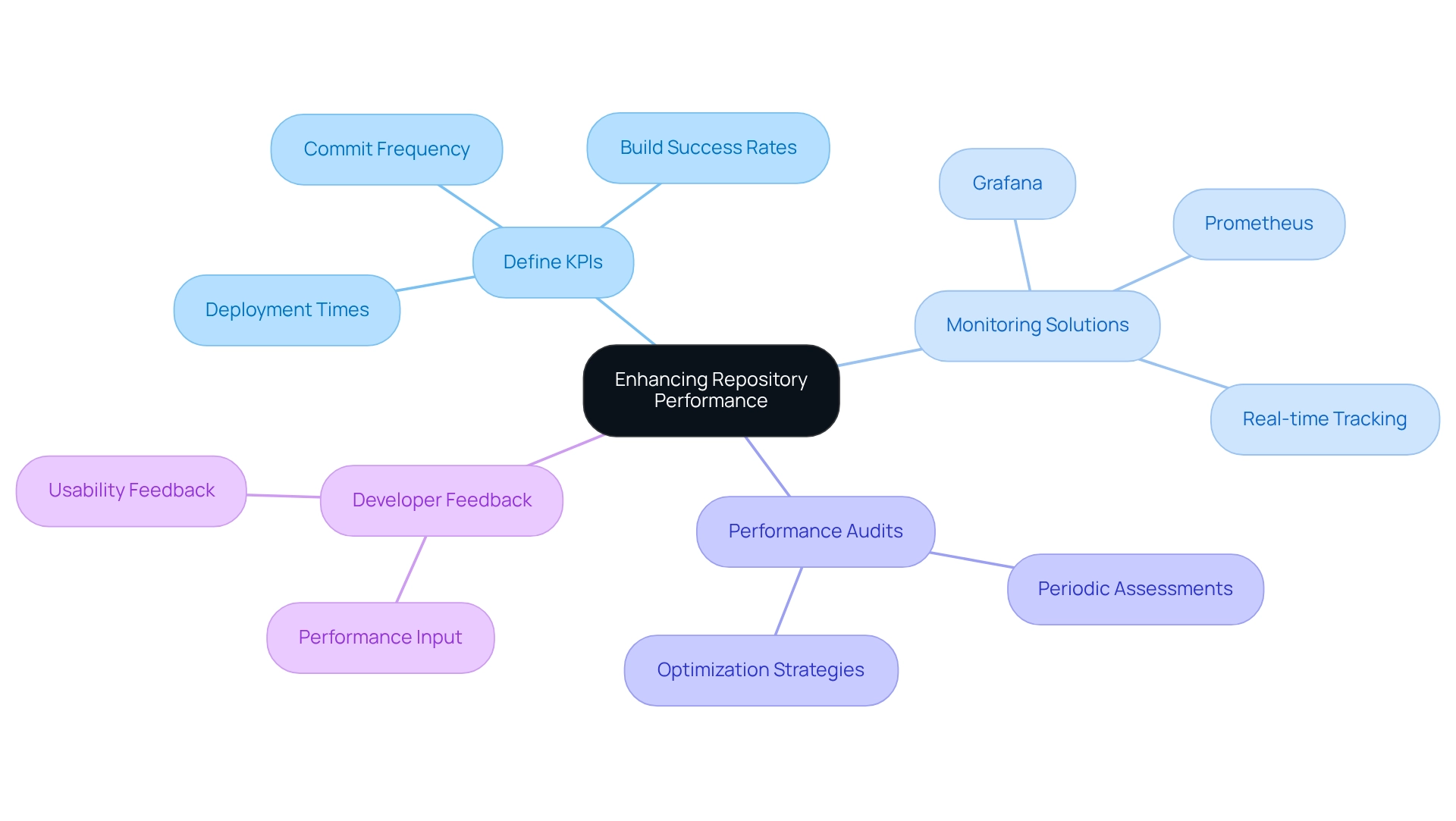Overview
To optimize Perforce repositories for maximum efficiency, developers often face significant coding challenges. Implementing best practices such as:
- Regular cleanup
- Clear naming conventions
- Automation of continuous integration and deployment processes
can be key to overcoming these obstacles. How can these strategies enhance collaboration and streamline workflows? By adopting these practices, developers not only improve overall repository management but also set the stage for better project outcomes.
Furthermore, the article details how these strategies contribute to enhanced collaboration among team members. Clear naming conventions and regular cleanup efforts lead to a more organized environment, making it easier for developers to navigate and manage repositories effectively. In addition, automation of continuous integration and deployment processes minimizes manual errors and accelerates development cycles.
Ultimately, embracing these best practices results in improved productivity and higher code quality. By optimizing repository management, developers can focus more on innovation rather than getting bogged down by inefficiencies. Explore how these practices can transform your development process and lead to successful project delivery.
Introduction
In the realm of software development, developers often face significant challenges in managing their code repositories effectively. How can teams foster collaboration and ensure streamlined workflows? Perforce, a leading version control system, addresses these challenges by offering a robust framework that enables developers to navigate complex project structures with ease. Understanding the intricacies of Perforce's repository architecture—comprising depots, branches, and streams—sets the foundation for successful project management.
As organizations increasingly rely on automation and continuous integration strategies, mastering best practices in repository management becomes essential. This article delves into the critical components of Perforce repository management, highlighting:
- Strategies for optimization
- Automation tools for enhanced efficiency
- The importance of monitoring performance to drive continuous improvement
By embracing these principles, development teams can significantly elevate their productivity and project outcomes in today's fast-paced digital landscape.
Understand Perforce Repository Structure and Functionality
Version control systems present various challenges for developers, particularly in managing versioned files effectively. These systems are organized into depots, which serve as collections of these files. Each depot can encompass multiple branches and streams, facilitating organized development workflows. A solid grasp of the hierarchy involving depots, branches, and streams is crucial for effective management of storage.
Developers are encouraged to utilize both the command-line interface (CLI) and graphical user interface (GUI) tools available in the system, such as P4V, to navigate and manage structure layouts efficiently. Understanding how file types and protections are handled within the system is essential for enhancing access and performance. Properly structuring repositories to align with project requirements can significantly improve collaboration and minimize bottlenecks during development.
Notably, a long-term user of the software has highlighted its seamless integration with their development engine, emphasizing the platform's reliability and the ease of tracking project history over the years. This user expressed great satisfaction with the software, particularly regarding its ability to streamline workflows and enhance project coordination.
With a 4.0 review rating from industry reviewers, reflecting user satisfaction and the effectiveness of resource oversight, the software continues to be a favored option among developers. As Solutions Engineer Jase Lindgren states, "Follow along with Solutions Engineer Jase Lindgren as he guides you through the next steps," underscoring the significance of expert assistance in enhancing version control.
Furthermore, to enhance efficiency, developers should be aware of common pitfalls in project oversight, such as inadequate branching strategies or poor file organization, which can hinder collaboration and slow down development processes.

Implement Best Practices for Repository Management
To optimize productivity, developers encounter various challenges in managing Perforce repositories. By adopting several best practices, teams can significantly enhance their workflows and collaboration.
- Regularly Review and Clean Up Repositories: Periodic evaluations of storage are essential for identifying and removing obsolete files and branches. Statistics suggest that regular cleanup can significantly improve performance and reduce clutter, leading to more efficient workflows. In fact, data storage systems are beginning to predict future trends, aiding proactive planning, which emphasizes the significance of keeping a clean database.
- Use Descriptive Naming Conventions: Implementing clear and consistent naming conventions for branches and files is crucial. This practice not only enhances readability but also improves navigation efficiency within Perforce repositories, allowing team members to locate resources quickly and intuitively. This ensures that only authorized personnel can make changes, thereby safeguarding the integrity of the codebase.
- Conduct Code Reviews: Establishing a culture of code reviews before merging changes into the main branch is a best practice that enhances code quality. Case studies show that collaborative code reviews, such as those facilitated by TeamHub, improve accountability and foster knowledge sharing among team members, ultimately leading to better software outcomes.
- Document Storage Framework: Maintaining comprehensive documentation of the storage framework and operational practices is essential for facilitating onboarding and ensuring consistency across the team. This documentation acts as a valuable resource for both new and current team members, fostering a common understanding of project oversight. As the development of data storage systems progresses, effective documentation becomes increasingly vital in adjusting to new trends.
- Avoid Common Pitfalls: It is essential to be aware of frequent traps in resource handling, such as neglecting regular cleanup or failing to enforce naming conventions. By acknowledging these challenges, teams can more effectively implement best practices and improve their resource oversight strategies.
By applying these best practices, teams can significantly improve the efficiency and effectiveness of their version control system, paving the way for enhanced collaboration and productivity. As Sarah Lee observed, examining present big data analytics trends can enhance business growth, emphasizing the significance of efficient data storage in today’s data-driven environment.

Leverage Automation Tools for Continuous Integration and Deployment
Integrating automation solutions into workflows is essential to maximize efficiency in Perforce repositories. Developers often face significant coding challenges that hinder productivity. How can these challenges be effectively addressed? Integrating automation strategies is key.
Utilize CI/CD Solutions: Implementing systems like Jenkins or Travis CI can significantly streamline the build and testing processes. These resources can be set up to initiate builds automatically upon code commits, ensuring seamless integration and minimizing manual intervention. Notably, Kubernetes can manage demand variations up to 10 times more effectively than conventional setups, emphasizing the efficiency of such automation systems in handling performance.
Automate Code Quality Checks: Incorporating static analysis software enables automatic reviews of code quality and security vulnerabilities prior to merging changes. This proactive approach not only helps maintain high standards in the codebase but also mitigates potential security risks, such as data leaks and faulty plugins. Addressing these risks is crucial in today’s software development landscape. Furthermore, Kodezi’s automated code debugging feature can instantly identify and fix codebase issues, providing detailed explanations of what went wrong and how to resolve it. This further enhances code quality and security compliance. Kodezi distinguishes itself by providing real-time bug analysis and automatic code correction, separating it from conventional static analysis resources.
Set Up Automated Deployment Pipelines: Creating deployment pipelines that automate the release process can drastically reduce the time and effort required to deploy new features or fixes. This includes automating testing, staging, and production deployments, which enhances overall operational efficiency. Kodezi’s AI-driven automated builds and testing can significantly improve code quality in software development, ensuring that deployments are both rapid and reliable.
Monitor Automation Performance: Regular evaluation of automation resources is essential for pinpointing bottlenecks or failures within the CI/CD pipeline. Continuous monitoring enables teams to make necessary adjustments and improvements, ensuring that the automation processes remain effective and efficient.
The adoption of these automation strategies not only improves deployment times but also aligns with current trends in CI/CD tool adoption among developers. As highlighted in the case study titled "DevOps in Large Organizations," companies like Amazon and Netflix have successfully leveraged DevOps practices to enhance security and optimize service delivery. Dabidi Sanyika, CD Foundation Governing Board Chair, noted, "The report findings reflect our community's ongoing efforts and provide a framework for organizations to compare their practices with those of their industry peers, offering insights into where they stand and highlighting areas that require attention to enhance organizational efficiency.

Monitor and Measure Repository Performance for Continuous Improvement
To enhance the performance of perforce repositories, teams must tackle the coding challenges that developers frequently encounter. By adopting comprehensive monitoring and measurement practices, they can drive continuous improvement.
First, it's crucial to define Key Performance Indicators (KPIs). Establishing essential KPIs such as commit frequency, build success rates, and deployment times provides valuable insights into development processes. As Bill Harding, CEO of GitClear, emphasizes, quantifying valuable questions is vital for effective KPI definition.
Next, teams should employ monitoring solutions like Grafana or Prometheus. These tools visualize performance metrics and track project health in real-time. By identifying trends and potential issues proactively, teams can ensure timely interventions before problems escalate.
Furthermore, conducting regular performance audits is essential. Scheduling periodic assessments against established KPIs allows teams to gain insights that inform optimization strategies and necessary workflow adjustments. The evolving landscape of KPIs, as illustrated in the case study "The Future of KPIs in Project Management," indicates that advancements in technology enhance project management capabilities, enabling continuous tracking of KPIs.
In addition, actively gathering developer feedback is crucial. Requesting input regarding the performance and usability of the codebase provides qualitative data that complements quantitative metrics. This approach reveals areas for improvement that may not be immediately visible. Focusing on the most pertinent KPIs for project success is essential for enhancing system performance.
By concentrating on these practices, teams can significantly boost the efficiency and effectiveness of their perforce repositories, ultimately leading to improved project outcomes.

Conclusion
Effective management of Perforce repositories is crucial for development teams facing coding challenges. Understanding the repository structure—comprising depots, branches, and streams—enables developers to navigate their projects with greater ease and efficiency. By implementing best practices such as:
- Regular repository cleanups
- Clear naming conventions
- Enforcing access controls
- Conducting thorough code reviews
teams not only optimize repository performance but also cultivate a culture of accountability and knowledge sharing.
Furthermore, leveraging automation tools is essential in today’s fast-paced development environment. Integrating CI/CD tools and establishing automated deployment pipelines can significantly minimize manual intervention, ensuring rapid and reliable releases. Continuous monitoring of these automation processes, along with regular performance assessments, allows teams to identify and address bottlenecks proactively, ultimately driving continuous improvement.
In summary, mastering Perforce repository management empowers development teams to boost productivity and achieve better project outcomes. By embracing these strategies and best practices, organizations can navigate the complexities of software development more effectively. This positions them for success in an increasingly data-driven landscape. Prioritizing these principles is not just an operational necessity; it is a strategic advantage that can lead to enhanced performance and competitive differentiation in the software industry.
Frequently Asked Questions
What are the main challenges developers face with version control systems?
Developers encounter challenges in managing versioned files effectively, particularly in understanding the hierarchy of depots, branches, and streams.
What is a depot in the context of version control systems?
A depot is a collection of versioned files that can encompass multiple branches and streams, facilitating organized development workflows.
How can developers manage their version control systems effectively?
Developers are encouraged to utilize both command-line interface (CLI) and graphical user interface (GUI) tools, such as P4V, to navigate and manage structure layouts efficiently.
Why is understanding file types and protections important in version control?
Understanding how file types and protections are handled enhances access and performance within the version control system.
How can properly structuring repositories benefit development?
Properly structuring repositories to align with project requirements can significantly improve collaboration and minimize bottlenecks during development.
What feedback has been provided by long-term users of the software?
Long-term users have highlighted the software's seamless integration with their development engine, reliability, and ease of tracking project history, expressing satisfaction with its ability to streamline workflows.
What is the software's review rating and what does it indicate?
The software has a 4.0 review rating from industry reviewers, indicating user satisfaction and effectiveness in resource oversight.
What common pitfalls should developers be aware of in project oversight?
Developers should be aware of inadequate branching strategies and poor file organization, as these can hinder collaboration and slow down development processes.




